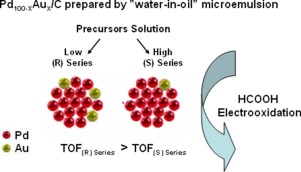当前位置:
X-MOL 学术
›
Appl. Catal. B Environ. Energy
›
论文详情
Our official English website, www.x-mol.net, welcomes your
feedback! (Note: you will need to create a separate account there.)
Carbon-supported Pd100-XAuX alloy nanoparticles for the electrocatalytic oxidation of formic acid; influence of metal particles composition on activity enhancement
Applied Catalysis B: Environment and Energy ( IF 20.2 ) Pub Date : 2017-09-18 , DOI: 10.1016/j.apcatb.2017.09.039 T. Szumełda , A. Drelinkiewicz , E. Lalik , R. Kosydar , D. Duraczyńska , J. Gurgul
Applied Catalysis B: Environment and Energy ( IF 20.2 ) Pub Date : 2017-09-18 , DOI: 10.1016/j.apcatb.2017.09.039 T. Szumełda , A. Drelinkiewicz , E. Lalik , R. Kosydar , D. Duraczyńska , J. Gurgul

|
Two series of carbon-supported Pd100-XAuX catalysts of different Au contents have been synthesised by the “water-in-oil” microemulsion method (Triton X 114, cyclohexane) using precursor solutions of low (series L) and high concentration (series H). The metal nanoparticles are characterized by XRD, electron microscopy (SEM, HRTEM) and XPS to determine their crystal structure, particles size, composition and morphology. The electrochemical measurements provide data concerning surface properties of the PdAu particles, including surface fraction of Pd and Au and the reactivity towards hydrogen sorption/desorption processes. The metal particles of low bulk Au-content (Au/Pd < 1) are of high monodispersity and of smaller size than their monometallic Pd and Au counterparts, synthesized by the same method. At higher bulk Au-content (Au/Pd > 1), the particle size increases approaching almost the size of Au particles. An enrichment of Pd toward the surface of all the Pd100-XAuX particles occurs, much pronounced in the samples H series. The activity of catalysts (based on the current densities, and TOF values) in the electrooxidation of formic acid (FA) is correlated with the bulk and surface composition of the Pd100-XAuX particles. The high monodispersity of the metal particle size in the studied catalysts made it possible to observe relation between FA electrooxidation activity and surface composition of the PdAu particles. The catalytically active sites formed at the Au surface fraction ca. 0.1-0.12 (Pd 0.9 − 0.88) display 1.6-times higher activity (TOF) as compared to pure Pd, while higher surface Au fraction strongly reduces activity. The occurrence of electronic modification of Pd by Au in the Pd100-XAuX particles also results in a reduced hydrogen solubility, accompanied by weaker Pd-H bonds, which might influence the poisoning ability by CO formed through electroreduction of CO2, the product of FA oxidation
中文翻译:

碳载Pd 100-X Au X合金纳米颗粒,用于甲酸的电催化氧化;金属颗粒组成对活性增强的影响
两个系列的碳载Pd 100-X Au X使用低(L系列)和高浓度(H系列)的前体溶液,通过“油包水”微乳液法(Triton X 114,环己烷)合成了不同Au含量的催化剂。通过X射线衍射,电子显微镜(SEM,HRTEM)和XPS对金属纳米颗粒进行表征,以确定其晶体结构,粒径,组成和形态。电化学测量提供了有关PdAu颗粒表面特性的数据,包括Pd和Au的表面分数以及对氢吸附/解吸过程的反应性。与通过相同方法合成的单金属Pd和Au对应物相比,低的Au含量(Au / Pd <1)的金属颗粒具有较高的单分散性和较小的尺寸。在较高的Au含量(Au / Pd> 1)下,颗粒的增加几乎达到了Au颗粒的大小。朝向所有Pd表面的Pd富集出现100-X Au X粒子,这在样品H系列中非常明显。甲酸(FA)电氧化中的催化剂活性(基于电流密度和TOF值)与Pd 100-X Au X颗粒的体积和表面组成相关。在所研究的催化剂中,金属粒度的高单分散性使得观察FA电氧化活性与PdAu颗粒的表面组成之间的关系成为可能。大约在Au表面部分上形成的催化活性位。0.1-0.12(Pd 0.9-0.88)的活性(TOF)是纯Pd的1.6倍,而较高的表面Au含量则大大降低了活性。钯中金被金电子修饰的现象100-X Au X颗粒还会导致氢溶解度降低,并伴有较弱的Pd-H键,这可能会影响由FA氧化产物CO 2的电还原而形成的CO的中毒能力。
更新日期:2017-09-19
中文翻译:

碳载Pd 100-X Au X合金纳米颗粒,用于甲酸的电催化氧化;金属颗粒组成对活性增强的影响
两个系列的碳载Pd 100-X Au X使用低(L系列)和高浓度(H系列)的前体溶液,通过“油包水”微乳液法(Triton X 114,环己烷)合成了不同Au含量的催化剂。通过X射线衍射,电子显微镜(SEM,HRTEM)和XPS对金属纳米颗粒进行表征,以确定其晶体结构,粒径,组成和形态。电化学测量提供了有关PdAu颗粒表面特性的数据,包括Pd和Au的表面分数以及对氢吸附/解吸过程的反应性。与通过相同方法合成的单金属Pd和Au对应物相比,低的Au含量(Au / Pd <1)的金属颗粒具有较高的单分散性和较小的尺寸。在较高的Au含量(Au / Pd> 1)下,颗粒的增加几乎达到了Au颗粒的大小。朝向所有Pd表面的Pd富集出现100-X Au X粒子,这在样品H系列中非常明显。甲酸(FA)电氧化中的催化剂活性(基于电流密度和TOF值)与Pd 100-X Au X颗粒的体积和表面组成相关。在所研究的催化剂中,金属粒度的高单分散性使得观察FA电氧化活性与PdAu颗粒的表面组成之间的关系成为可能。大约在Au表面部分上形成的催化活性位。0.1-0.12(Pd 0.9-0.88)的活性(TOF)是纯Pd的1.6倍,而较高的表面Au含量则大大降低了活性。钯中金被金电子修饰的现象100-X Au X颗粒还会导致氢溶解度降低,并伴有较弱的Pd-H键,这可能会影响由FA氧化产物CO 2的电还原而形成的CO的中毒能力。











































 京公网安备 11010802027423号
京公网安备 11010802027423号